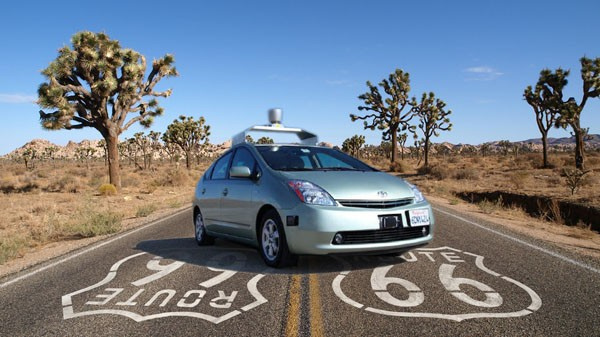Top image credit: Sam Churchill.
Back in February, a confluence of thinkers, designers, and planners converged in San Francisco (brought together by Arup) to discuss the implications of autonomous cars on the built environment. The question posed to the group: "How might our streets, buildings, neighborhoods, and regions change as the autonomous car becomes commonplace and even ubiquitous?"
On the positive end of the spectrum, proponents believe that autonomous cars could dramatically reduce the number of cars by encouraging fractional ownership and use — a sort of carsharing on steroids scenario. Hypothetically, one shared driverless car could replace up to six privately owned vehicles. Another tick in the plus column is that people who can't drive due to age or health issues would enjoy a newfound independence in a driverless world. And that group accounts for around 25 percent of the U.S. population.

Photo credit: Melody Kramer / Foter / CC BY-NC-ND 2.0.
Potentially significant reductions in traffic, pollution, and accidents, along with decreased physical space demands for parking and streets, add further weight to the pro team. Fewer cars on the roads means more room (and safety!) for bicycles and pedestrians. Hans Larsen, the City of San Jose's director of transportation, noted, “I think there is a huge opportunity. In a suburban environment, about half of developed land is car storage, so that opens up great opportunity for infill development.” Darby Watson, from San Francisco's Livable Streets program, knows from her successes boosting bike usage that “if we build the infrastructure, driverless vehicles will come.”
So when will this technology be put to use? While much of the technology and regulation is already in place (driverless cars are legal in Nevada and California), experts believe things will start to take off around 2018.
It's a long road between here and there, though. And myriad changes would likely need to be made to the built environment and there's an opportunity to repurpose automobile infrastructure for better uses:
- Designing more efficient traffic patterns
- Developing and implementing communication systems between parking structures and autonomous cars
- Shifting focus to updating, rather than expanding, existing automobile infrastructure
- Designing and building electronic components into highways and roadways
- Converting unneeded on-street parking to bike lines
- Repurposing unused parking lots and structures for other uses, such as housing, playgrounds, parks, and gardens
On top of that, some smart growth and new urbanism experts feel that the whole movement runs counter to their push to get people out of cars and to limit suburban sprawl. They insist that carsharing would absolutely have to be built into an autonomous system, otherwise it becomes just another problem — and one enjoyed only by the elite — rather than a solution that benefits the masses. Because such a huge chunk of a city's financial stability is tethered to its property values, shifts in public policy and land use to make way for autonomous cars are also huge concerns due to the economic repercussions.
The Council of Foreign Relations also gathered some great minds to discuss the future of/with autonomous vehicles. Their panel, moderated by James Shinn of Princeton University, included MIT's Erik Brynjolfsson, Intel's Jennifer Healey, and the Devil's Advocate Group's Chunka Mui delved into the economic, legal, and policy questions of the notion.









